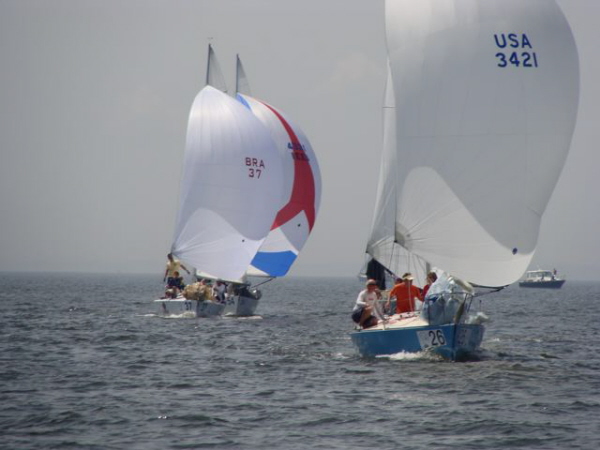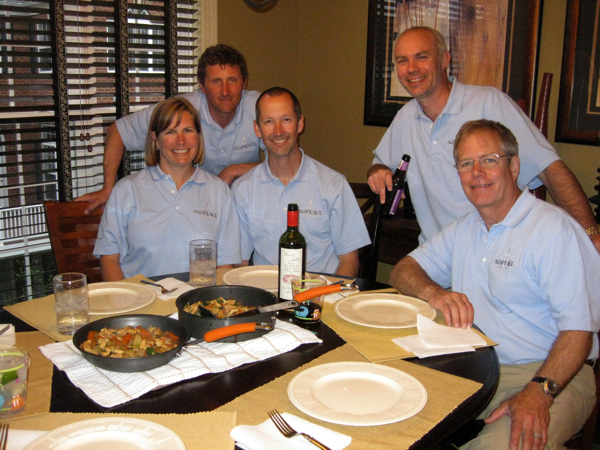
CYC Home
June 2009
By Eric Sanderson
What did I take away from this?
Making a commitment to sail in the 2009 J/24 World Championships in Annapolis, Md., entailed hundreds of hours of boat preparation, endless coordination with my four crewmembers and their families, a cross-country road trip hauling my boat, Suspence, with a Toyota pickup, two regattas on the Chesapeake Bay and a fair amount of frustration on the water punctuated by flashes of excellence.
In the end, the experience cemented my belief that the J/24 Class is a great class with a lot of nice people who work hard to make it possible. It also underscored the importance of being prepared when you get there.

Photo by Kelly Pensell
Eric Sanderson and the crew of Suspence, foreground, lead eventual regatta winner Mauricio Santa Cruz of Brazil on Bruschetta (37) on a leeward leg during the J/24 World Championships in Annapolis.
Sailing at such a high level was a new experience for most of us. Competitors in the regatta, held May 4 - 8, included five former J/24 world champions and a host of Continental and National champions from Europe and the Americas. All 79 entries had to qualify for the event, which we did by winning the Columbia Gorge One-Design Regatta, a qualifying event, last year.
We had a timeline for working on the boat that called for getting it on the water early enough to get in plenty of practice and, maybe, hiring a coach. But even though the boat was in pretty good shape to begin with, our first mistake was probably overdoing our boat preparation.
In addition to hardware upgrades, bottom work and dozens of minor upgrades (most of which took more time than we anticipated), we repositioned our mast slightly to align it with the keel and rudder. That fix definitely improved our performance, but it also consumed valuable time that we could have spent on the water.
As our mid-April departure date approached, our boat wasn't ready, and we ended up practicing only two or three times on a borrowed boat before we left.
We also added a new crewmember, Joel Thornton, who is very talented and experienced. But as we all know, it takes some time together on the water to gel as a crew.
In preparation for the Worlds, we sailed the Annapolis NOOD regatta April 24-26, finishing 35th out of 52 boats, learning to sail in the unfamiliar conditions of Chesapeake Bay while shaking out the cobwebs of winter.

The crew of Suspence during a night on the town in Annapolis included, from left, Melanie Edwards, Chris Roberts, Eric Sanderson, Carl Sheath and Joel Thornton,
The chop was formidable and we had to change sail trim and adjust steering to deal with it, but once we nailed down those things, we sailed quite well. Also, current lines that we would have recognized on Puget Sound were hard to see on the Chesapeake. Even people who sailed there regularly said the conditions were among the more challenging they had seen.
Every boat sailing in the World Championship was fully measured in Annapolis, and all of our winter and spring work helped us sail through that process. Others weren't so fortunate, many having to add material here or there to conform. Measurers also found more serious infractions, including a couple of boats that had lead shot poured into their keel sumps or epoxied under their cabin soles. Remnants of another time.
Day one of the Worlds opened with our conditions - 15 to 18 knots, top of the genoa. We got a serviceable start, crossed tacks with some of the big dogs, and rounded the weather mark about15th. Then our lack of time on the water began to hurt us. We had a bad hoist, lost track of the wind, gybed away from the fleet and ended up about 40th at the leeward mark. In this fleet, mistakes were painful.
There was no wind on day two, and on day three and four the wind was light and variable, as were our finishes. The last race on day four finished in a thunderstorm with 180-degree wind shift that found us head to wind near the finish line. Boats we had led passed us on both sides, turning a good finish into a 55th.
We sailed well on day five, beating last year's world champion in two of three races. Our best race was our first that day, a 13th, when we finally felt that we were performing up to our capabilities. Our final place was 43rd, not what we had expected but not bad considering the amount of time we had on the water before the regatta.
My crew for the regatta was Chris Roberts, trim, Carl Sheath, tactics, Joel Thornton, mast, and Melanie Edwards, foredeck. Thanks to them for their countless hours preparing Suspence and to their families, partners and children for their patience.
Another Seattle J/24 sailor, Harry Brown, also took his crew to Annapolis, finishing 56th on a chartered boat.
Seattle fleet members led by Hans Spiller, also assisted with measuring. Joining Spiller as apprentice measurers were Noel Morgan and Mike Johnson, with help from Johnson's wife, Joy Okazaki.
Holding down the home fort in Seattle was my wife Karrie, whom I thank for her support and patience during the nearly three weeks I was off on this adventure. Not to mention the nights and weekends spent preparing.
I learned a lot and met a lot of great people from the U.S. and around the world. It's a heck of a commitment to prepare a boat, transport it across the country and coordinate the schedules of five families.
But I've got the bug to do it again, though not in the near future. Perhaps with the family as crew!